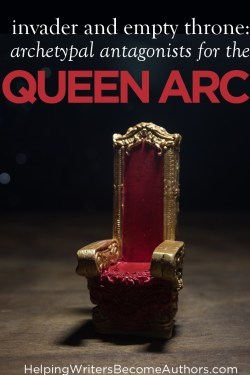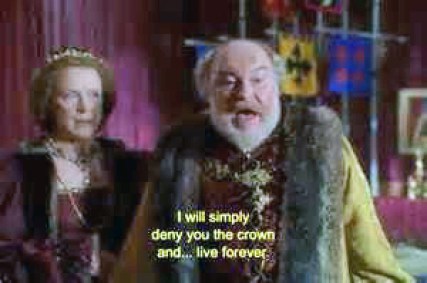Archetypal Antagonists for the Queen Arc: Invader and Empty Throne
 As the third of the life cycle’s archetypal character arcs, the Queen Arc is that of the mature adult who has completed the youthful arcs of Hero and Maiden and is now challenged to grow into a position of greater responsibility and leadership. This is the tale of someone who has so far proven herself worthy of love and responsibility in relationship, community, and perhaps parenthood. But now life calls for a further transformation—into capably accepting a true position of power.
As the third of the life cycle’s archetypal character arcs, the Queen Arc is that of the mature adult who has completed the youthful arcs of Hero and Maiden and is now challenged to grow into a position of greater responsibility and leadership. This is the tale of someone who has so far proven herself worthy of love and responsibility in relationship, community, and perhaps parenthood. But now life calls for a further transformation—into capably accepting a true position of power.
The Queen Arc can be seen to come after the well-known Hero Arc both mythically in the sense that “what happens after” the Hero Arc is often the victorious Hero being given a position of leadership. More prosaically, it can be seen simply in the life of a modern person who has successfully “grown up” (with the “Quest” signified by perhaps going to college, getting married, or committing to a career) and who is now beginning to tend the needs of the up-and-coming generation.
If the Hero Arc was about reconciling the potential for Power with the goodness of Love, the Queen Arc then is about recognizing that leadership requires not just Love but also the ability to create Order. As such, the Queen’s archetypal antagonists can be seen to be represented by the twofold threat of Invaders from beyond her happy home and the Empty Throne that fails to protect her and her family. Together, these two antagonistic forces are what catalyze the need for her next transformative arc. There is a dearth of leadership in the Kingdom, and she is being called to fulfill it.
The Queen’s Antagonists: Practical and ThematicOnce again, we can see in these dualistic archetypal antagonists the two faces of a story’s conflict: outer and inner, plot and theme. One represents the main thrust of the external conflict—whatever or whoever is framing the larger conflict and therefore the need for the Queen’s ultimate plot goal of protecting or furthering those who depend upon her. The other antagonistic force represents more specifically the protagonist’s inner drama—the inner obstacles that are both driving and blocking her ability to become the person she needs to be in order to triumph in the external conflict.
Usually in a Queen Arc, the Invader represents the outer antagonist and the Empty Throne represents the inner antagonist. However, as with all of these symbolic antagonists, it is possible to achieve many flexible dynamics. For example, if the Empty Throne is truly empty, it may be an antagonistic force represented almost entirely by the Queen’s own insecurities or inner resistance to sitting upon that throne. But if the throne is empty symbolically, in the sense that the current leadership is corrupt, then she may face a Tyrant character (perhaps in a Contagonist role) who must be defeated before she can truly save the Kingdom from the Invaders.
Invader as Archetypal AntagonistThe Queen Arc is just one step up from the very dualistic mindset of the Hero Arc—in which the Hero faced the “evil other” of the animalistic Dragon. The Queen’s primary external antagonist is also still fundamentally viewed as “other,” although this time the antagonist is at least humanized. Because the Queen’s purview of life is still comparatively small (i.e., the Kingdom), she starts out still operating from a very “us vs. them” mindset. Her heart belongs to her people and only her people.
And so when a threat arrives from “outside” the Kingdom, it is accepted as a danger to all she holds dear. Probably this antagonistic force of Invader is also operating from this same “us vs. them” mindset, although more aggressively than defensively.
As such, there is certainly room within the Queen Arc to explore broadening mindsets. The Queen may end her story by subduing the Invaders, but she may also come to terms with them, inviting them into the protection of her Kingdom (now that she has transitioned into a fully realized Ruler) as equals rather than conquests. Regardless, part of the Queen’s transformation is that of mentally moving into a larger setting. She begins her story feeling safe within the walls of the Kingdom and ends by looking beyond the walls to the larger realm to which she is now accountable and responsible.
What is most foundational to the Invader as an archetypal antagonist is that it begins the story by presenting a real threat to the “home life” the Queen has built and which she holds so dear. She probably has no real desire to become a Ruler (or, if she does, she struggles with its ambitious shadow aspects). But the Invader catalyzes the necessity of her growth. If she wishes to protect what she has built, she must expand her capabilities.
Empty Throne as Archetypal AntagonistIf the throne were not empty, there would be no need for the Queen to undergo her arc. She begins the story not as the King but as the Queen. It’s not her job to defend the Kingdom from Invaders. But when she faithfully looks to the existing leadership paradigm to do just that, she discovers the throne is empty.
This may not be an instantaneous discovery. Gradually, it will become clear to both the Queen and her children that nobody is helming the ship. Or if someone is steering, he is doing either a wretchedly incompetent or a criminally corrupt job of it.
The Invader represents the catalyst that prompts the Queen’s journey, but it is the Empty Throne that demands she complete it. However happy she may (or may not) be to act as the Ruler’s lieutenant, there is in fact no true Ruler for her to support. If she’s going to achieve her plot goal and defend the needs of her family, she will have to rise to the task herself.
Often, the Empty Throne will be represented by a Tyrant character who must be overthrown in order to protect the Kingdom from the larger threat of the Invader. Although the Tyrant may indeed damage the Kingdom in his own right, he is not initially so great a threat that he immediately prompts the Queen to confront him. He is perhaps more a petty tyrant than a violent one (in the latter case he could likely be considered an Invader in his own right). Most importantly, the Tyrant proves himself the obstacle standing between the Queen and the defeat of the Invaders.
It’s also important to note that the Empty Throne need not always be representative of an evil force—of negligence or corruption. Because the Queen Arc marks a healthy and necessary progression in life, there is implicit within the arc the understanding that the throne must be cyclically vacated. Indeed, as we’ve explored previously, the King Arc is that of willingly stepping down from power for the good of all.
The Queen may be preceded by a good King, one who has faithfully sacrificed his leadership to protect his Kingdom. Indeed, he may do so in congruence with the Queen’s own arc. If in this case, the Empty Throne will be a naturally arising challenge for the Queen to grow into. But even in this scenario, the Empty Throne remains representative of an antagonistic force because it signifies the Queen’s inner resistance to fully accepting this throne. When offered the crown, she may, like Prince Henry in Ever After, declare, “I don’t want it!”

Or she may be wary of her own tyrannical proclivities should she be given so much power over other people’s lives—such as with Aragorn in the film versions of The Lord of the Rings, who feared his lineage’s weakness for the Ring’s dark power.

The Invader will usually be the primary actor in the external conflict (even if it is just a framing conflict). The bulk of a story’s scenes may be about the dynamic between the Queen and the Empty Throne, but the central thrust of the plot is toward and in response to the Invader. The “invasion” may be featured in many different guises, everything from the slow advance of a literal enemy force to the encroaching deadline for a neighborhood’s destruction to a high school presidential campaign against a brazen newcomer. Whatever the case, this is the primary obstacle the Queen is focused on, in ways large and small, on every page of the story.
The Empty Throne, meanwhile, may be one of many obstacles she faces on her route to fending off the Invader, but it is the main obstacle. As such, it may well take up many of the book’s scenes as the Queen grapples with either overthrowing a Tyrant and/or claiming her own true leadership capacity in order to do what is necessary to defend the Kingdom.
The Invader will likely be the primary antagonist defeated in the Climactic Moment. Even if the Queen has yet to officially take the throne upon defeating the Invaders, her defeat of the Empty Throne will not be the Climactic Moment. The only exception is if the Tyrant and the Invader are represented by the same character or force, in which case she will, of course, defeat both archetypes simultaneously.
Although the classic symbolism of this story indicates the Queen will repel the Invader by force and literally take the throne, becoming an uncontested leader, the actual stories need not be so simplistic. It may be that instead of subjugating the Invaders, she reconciles with them, either inviting them under her protection as subjects of her realm or respecting them as a sovereign nation in their own right. It may also be that she does not take someone else’s physical throne, but simply learns to inhabit the Empty Throne in her own heart, embodying true sovereignty without necessarily ruling over a specific Kingdom or people (family, business, etc.).
In whatever way the archetypal antagonists of Invader and Empty Throne manifest in your Queen-Arc story, what is most important is that they represent the catalytic necessity for the Queen’s own growth into a true “servant-leader.”
Stay Tuned: Next week, we will explore the archetypal antagonists of the King Arc: Cataclysm and Rebels.
Related Posts:
Story Theory and the Quest for MeaningAn Introduction to Archetypal StoriesArchetypal Character Arcs: A New SeriesThe Maiden ArcThe Hero ArcThe Queen ArcThe King ArcThe Crone ArcThe Mage ArcIntroduction to the 12 Negative ArchetypesThe Maiden’s Shadow ArchetypesThe Hero’s Shadow ArchetypesThe Queen’s Shadow ArchetypesThe King’s Shadow ArchetypesThe Crone’s Shadow ArchetypesThe Mage’s Shadow ArchetypesIntroduction the 6 Flat ArchetypesThe ChildThe LoverThe ParentThe RulerThe ElderThe MentorHow to Use Archetypal Character Arcs in Your StoriesSummary of the Archetypal Character ArcsArchetypal Antagonists for Each of the Six Archetypal Character ArcsMaiden Arc: Authority and PredatorHero Arc: Dragon and Sick KingWordplayers, tell me your opinions! Can you think of any more examples of the Invader and the Empty Throne in Queen-Arc stories? Tell me in the comments!Click the “Play” button to Listen to Audio Version (or subscribe to the Helping Writers Become Authors podcast in Apple Podcast or Amazon Music).
___
Love Helping Writers Become Authors? You can now become a patron. (Huge thanks to those of you who are already part of my Patreon family!)The post Archetypal Antagonists for the Queen Arc: Invader and Empty Throne appeared first on Helping Writers Become Authors.




